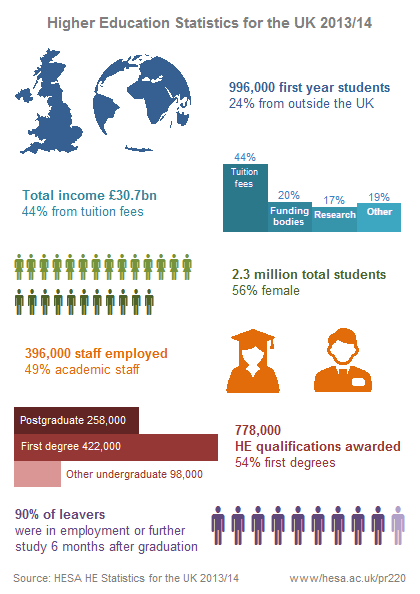Overview of the academic year 2013/14
The HESA publication Higher Education Statistics for the United Kingdom 2013/14 is released today. This National Statistics publication gives a statistical overview of UK higher education (HE) in the 2013/14 academic year including data from HESA and other statistics producers. Commentary, summary tables and charts are provided in the free online introduction.

Details from the 2013/14 introduction include:
Applications
563,320 UK domicile UCAS applicants and 434,685 acceptances [Table A of the free introduction].
Students
2,299,355 HE students at HE providers* (HEPs), plus 189,040 HE students at FE colleges [Table B of the free introduction].
56% of HE students are female [Table C of the free introduction].
44% of students studied science subjects. The most popular subject area was business & administrative studies which was studied by15% of students [Table D of the free introduction].
Qualifications
777,555 HE qualifications were awarded, of which 54% were first degrees and 33% postgraduate [Table E of the free introduction].
Leavers
90% of UK and EU domicile leavers were in some form of employment or further study six months after leaving. 6% were unemployed [Table F of the free introduction]
Medicine and dentistry leavers had the lowest rate of unemployment after leaving at 0.1%. Computer science leavers had the highest rate at 11% [Table G of the free introduction]
Staff
395,780 staff were employed in HEPs on 1 December 2013. 194,245 (49%) were academic staff [Table H of the free introduction]
45% of academic staff were female. 36% were employed on fixed-term contracts [Table I of the free introduction]
Finance
UK HEIs had a total income of £30.7 billion of which 44% came from tuition fees [Table J of the free introduction]
Student Loans
The Student Loans Company lent £6.2 billion in tuition fee loans [Table K of the free introduction]
HE Statistics for the UK Publication
Higher Education Statistics for the United Kingdom 2013/14 is a National Statistics publication including data from HESA and other statistics producers covering all aspects of Higher Education in the UK.
The 50 tables in the publication include
- Student, Staff, Finance and Destinations data from HESA
- Applications and admissions data from UCAS
- Data from the Student Loans Company on student support provision
- Information on participation and graduate rates for 30 countries from the OECD
- Data from the Labour Force Survey on qualification rates over time.
Higher Education Statistics for the United Kingdom 2013/14 is available to purchase now as an electronic download.
The free online introduction includes commentary, summary tables and charts and provides an overview of the key trends in higher education over the last five years.
Notes for Editors
- Press enquiries should be directed to:
- Simon Kemp
- HESA Press Officer
- 01242 211120
- [email protected]
- In the above data 0, 1, 2 are rounded to 0. All other numbers are rounded up or down to the nearest multiple of 5. Percentages are calculated on un-rounded numbers.
- HESA appreciates the collaboration of all the bodies that have made data available for this publication, and in particular that of our colleagues in the Department for Business, Innovation and Skills, Welsh Government, Scottish Government and the Department for Employment and Learning (Northern Ireland) with whom we have worked closely in preparing it, in accordance with the arrangements approved by the here.
- HESA cannot accept responsibility for any inferences or conclusions derived from the data by third parties.
About HESA
The Higher Education Statistics Agency (HESA) is the recognised source of data on higher education in the UK. Our experts collect, analyse, and disseminate accurate and comprehensive statistical information on all aspects of UK higher education in order to support the strategic aims of our users and enhance the effectiveness of the sector as a whole. We are a charity and a company limited by guarantee. We operate as an independent organisation, working in close partnership with higher education providers, regulators, funders, government departments, policy makers, and other stakeholders.
Ends

Press Officer
